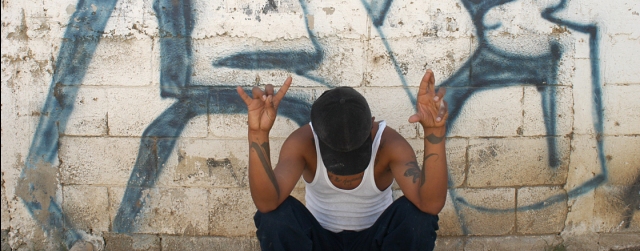Interpeace launches '12 strategies' for youth and youth gang violence prevention for Guatemala

In response to the urgent need for prevention policies to address youth and youth gang related violence in Central America, Interpeace has released the document ‘12 strategies' for Guatemala, the first report in a series of policy proposals that will cover the region.
Central America is now considered the most dangerous place in the world. Young people are most at risk from violence either as victims or perpetrators. There is now an urgent need for holistic and inclusive policies to address this pressing issue.
In Guatemala alone, over an 11 month period last year, 433 children under the age of 17 suffered violent deaths. 3,337 young people between the ages of 28-35 also died due to violence.
The first in a series of preventative policy proposals to cover the region, this document marks the culmination of a multi-sector dialogue process in which more than 200 representatives from 37 institutions, 59 organizations and 35 civil society and youth organizations took part. The majority of the dialogue process took place between October 2009 and September 2010 and was facilitated by Interpeace.
Download the full report Spanish
The presentation of the report, held in Guatemala, was attended by over 400 people, including representatives of organizations involved in the process. During the event an emotional tribute was made to all those young people who were involved in the dialogue process that contributed to the development of these recommendations, but who have since lost their lives.
A Government representative who received the report stressed the importance of violence prevention.
“We recognize that youth related violence is a major problem in our country, and we’re going to take this document very seriously. We understand this is a great contribution to the Vice-Ministry, as it is this institution that is responsible for prevention”
stated Mrs. Lorena Guerra, Deputy Minister for Community Support.
“For Guatemala, a country where over 70% of the population is under the age of 30, violence affecting youth as victims and perpetrators is a priority issue. Youth related violence is more than simply a question of public security. It is the result of social, public, political and economic problems that run deep within society,’’ explains Isabel Aguilar, Interpeace Director of the Regional Youth and Gang Violence Prevention Programme.
The search for solutions to the problem must be based on a holistic approach that addresses the factors that contribute to violence and, in turn, promotes strategies that foster the welfare and development of adolescents and youth. The responses to the problem of youth related violence have been largely reactive and repressive, and are not proving effective as they do not address the structural causes of the problem.
A traditional approach to addressing youth and adolescent related violence has been to take a repressive ‘mano dura’ approach. Isabel adds ‘’Violence breeds violence’’, which rings true as this approach includes actions that violate human rights, including:
- The mass detention of youth, coupled with harsh jail sentencing, as it is often assumed that all youth are active in gangs;
- Extra-judicial executions and practices of ‘social cleansing’, linked to groups associated with the police, which are carried out on children and youths; and
- The repressive actions (“mano dura”) also include law initiatives such as the “Anti-gang Law” which, among other things, stigmatizes young people and infringes upon the right of association.
“This ‘mano dura’ (iron-fisted) approach is proving ineffective in addressing the structural causes of the problem. Violence has become a way of dealing with social conflicts,” explains Isabel Aguilar, Interpeace Director of the Regional Youth and Gang Violence Prevention Programme. Aguilar adds, “Histories of intra-family violence, violent environments at school, truancy, dropping-out, youth unemployment, easy access to and consumption of alcohol and drugs, limited access to health services and migration issues are all contributing factors that increase the likelihood of young people being impacted by violence.”
The aim of preventative policies is to focus on treating the root causes of violence. Public policies must be developed that will sustainably tackle the issue through a holistic approach by adding preventative measures to the existing reactive ones.
The 12 clear strategies, and associated objectives and actions to combat youth violence approach the issue from three angles: primary, secondary and tertiary prevention:
Primary prevention: refers to general social and economic development measures with attention on the wellbeing of children, adolescents and youth.
Strategy 1: To promote programmes to prevent and eradicate violence against children, adolescents and youth.
Strategy 2: For those adolescents and youth that find themselves outside the school system, encouraging them to stay in schools or alternative education.
Strategy 3: To promote art, culture and sports as means of personal development and methods of preventing violence.
Strategy 4: To create opportunities for vocational training and employment experience especially for adolescents and youth-at-risk.
Strategy 5: To promote access for adolescents and youth to preventative
Secondary prevention: refers to measures to protect and improve the quality of life of vulnerable groups and groups-at-risk, e.g. abandoned youth, children living in the street, youngsters already showing a tendency to violent behaviour, but also communities and neighbourhoods that are marginalized and show a higher incidence of violence and insecurity.
Strategy 7: To promote the social integration or reintegration of people who are or were members of gangs (‘maras’/ ‘pandillas’), to prevent them from getting involved in violent activities.
Strategy 8: To increase and improve the services for victims of violence and promote the use of alternative methods to manage and transform conflicts.Strategy 9:To promote the prevention of delinquency and improve citizen security within the framework of respect for human rights.
Tertiary prevention: refers to measures focusing on the socialization and reintegration of those who have already been convicted as delinquents, in order to prevent them from relapsing.
Strategy 10: To speed up the legal process and prioritize measures and sanctions other than imprisonment.
Strategy 11: To promote programmes that provide holistic care to adolescents and youth who are kept in confinement in order to enable constructive socialization.
Strategy 12: To broaden the reach and scope, and improve the quality of programmes to facilitate the social reintegration of youth that have been in prison.
Recent studies have shown how deferent action considerably reduces the victim and crime indexes in the areas where these initiatives have successfully been run by the Guatemalan Government and NGOs.
“It is the inclusive nature of the process that makes this initiative both legitimate and ground-breaking. The content harnesses the valuable insight and input from all levels and sectors of Guatemalan society. This report also stands out as it is the first step in taking a holistic, preventative approach across the region,” highlights Scott M. Weber, Director-General of Interpeace.
Interpeace, an international peacebuilding organization, has been working with organizations in the Central American states of El Salvador, Honduras, Guatemala, Belize, Costa Rica, Panama, and Nicaragua to address the growing problem of adolescent and youth violence, as well as the youth gang phenomenon in the region. The proposals are being used to influence policy development with the Government of Guatemala taking the findings on board.
Download the full report Spanish























